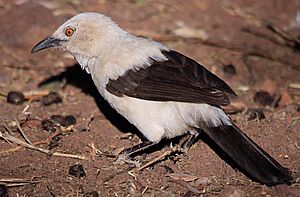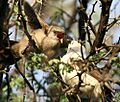Southern pied babbler facts for kids
Quick facts for kids Southern pied babbler |
|
|---|---|
 |
|
| At Marakele N. P., South Africa | |
| Conservation status | |
| Scientific classification | |
| Genus: |
Turdoides
|
| Species: |
bicolor
|
The southern pied babbler (Turdoides bicolor) is a type of bird found in the dry savannah areas of Botswana, Namibia, South Africa, and Zimbabwe. These birds are known for their black and white feathers.
Contents
About the Southern Pied Babbler
The southern pied babbler is a medium-sized bird, weighing about 75 to 95 grams (2.6 to 3.4 oz). They live in groups that can have 2 to 16 adults, but it's rare to see just a pair. Males and females look exactly alike.
In each group, there's a main breeding pair. This pair is usually the only one that has babies. Scientists have found that this main pair has over 95% of the young. Sometimes, other birds in the group might have babies, especially if a new bird joins or a new group starts. All the birds in the group work together to help raise the young from one nest. A female babbler usually lays two to five eggs, but most often, she lays three.
How Babblers Help Each Other
Pied babblers are very cooperative. This means they help each other in many ways:
- Feeding the young: They feed the babies in the nest and after they learn to fly.
- Lookout duty: Some birds act as "sentinels" or lookouts, watching for danger.
- Protecting their home: They defend their territory from other babbler groups.
- Teaching: Adults teach young babblers how to find food and stay safe.
- Babysitting: They watch over young birds that are still learning to be on their own.
The breeding season for babblers is usually from late September to early April. This can change depending on how much rain there is. A group can raise up to three sets of babies in one breeding season. Eggs hatch after about 14 days. The young birds leave the nest (fledge) about 16 days after hatching. Smaller groups tend to fledge their young sooner than larger groups.
After leaving the nest, young babblers can't fly well and rely completely on adults for food. They learn to find food slowly. Adults might feed them for up to four months after they fledge. The more care young babblers get, the stronger and better they become at finding food. This also helps them leave their home group and start having their own babies sooner.
Babbler Behavior and Learning
Sometimes, when the main breeding pair starts a new nest, they might act a bit rough with their older young. If the older young beg for food, the parents might jump on them. The young birds stop begging right away after this. This behavior helps the parents focus on their new babies. Other adult babblers in the group then take over caring for the older young. Because young babblers need care for a long time, a group might be raising babies from different nests at the same time!
Defending Their Territory
Pied babblers are very protective of their home area. They defend their borders almost every day using wing displays and loud calls. These "fights" rarely turn into real physical fights, and injuries are very rare. Groups stay in the same territory all year. Smaller groups sometimes lose parts of their territory to bigger groups nearby.
Babblers as Teachers
Scientists have found that pied babblers are one of the few bird species that actually "teach" their young. They do this by making a special purr call every time they bring food. Young babblers learn to connect this sound with food. They reach out of the nest whenever they hear it. Adults use this trick to get young birds to leave the nest. They make the purr call from a distance, encouraging the young to follow them out.
After the young leave the nest, adults keep using the call to get them to move between feeding spots or away from danger. This call also helps young birds find good places to eat.
How Heat Affects Learning
Research on pied babblers shows that very hot temperatures (above 38°C or 100°F) can make it harder for them to learn. Their ability to learn new things can be cut in half compared to normal temperatures (around 23°C or 73°F). This research suggests that climate change could affect how well wildlife survives.
Sharing the Work
Pied babblers also show "task partitioning." This means the main breeding pair can leave their young with other helpers and start a new nest. This allows them to raise several groups of babies at the same time. This shows how helpful cooperative breeding is: having many helpers lets the main pair have more babies. The parents start this by acting aggressively towards young birds that beg for food from them. This makes the young birds beg from the helpers instead, freeing up the parents to breed again.
Babblers and Other Animals
Pied babblers have an interesting relationship with a bird called the fork-tailed drongo. Drongos often sit above babbler groups and follow them as they look for food. Drongos make alarm calls when they see a predator. When drongos are around, babblers spend less time being lookouts themselves.
However, drongos sometimes make fake alarm calls. Then, they swoop down and steal the food that the babblers drop when they hear the "danger" call. This is called "kleptoparasitism."
Dealing with Drongos
Large babbler groups don't like drongos. They have enough birds to do their own lookout duty. So, they chase drongos away and don't lose much food to them. But small babbler groups don't have enough birds to be lookouts without affecting their time for finding food or feeding young. These small groups put up with the drongos stealing some food in exchange for the drongos' lookout help.
Young pied babblers have trouble handling big food items like scorpions or lizards. It takes them a long time to break these foods apart. This makes them easy targets for fork-tailed drongos. Research shows that drongos specifically target young babblers to steal food because it's easier for them.
Studying the Babblers
The Pied Babbler Research Project started in 2003. Dr. Amanda Ridley began it to study how these birds cooperate over a long time. The birds in this project are used to people, so scientists can study them closely. There are usually 10 to 18 babbler groups in the study area each year. Scientists and students continuously study them. They look at how the population changes, why birds help each other, how they find food, how they talk to each other, and many other things about their lives.
Staying Healthy: Avoiding Inbreeding
Pied babblers avoid having babies with close relatives in two main ways. First, young birds often move away from their birth group. They go far enough away that they are unlikely to meet relatives. Second, even within their own group, a bird will only become a breeding partner if the other bird is not related to them.
Avoiding inbreeding is important because it helps keep the babies healthy. When closely related animals have babies, the young can sometimes have health problems.
Images for kids












